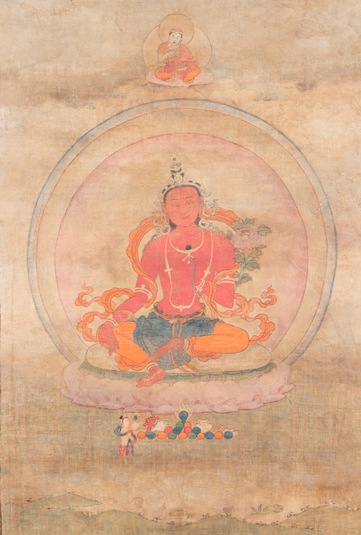
Item: Tara (Buddhist Deity) - Red
| Origin Location | Tibet |
|---|---|
| Date Range | 1700 - 1799 |
| Lineages | Kagyu, Karma (Kagyu) and Buddhist |
| Material | Ground Mineral Pigment on Cotton |
| Collection | Private |
Classification: Deity
Appearance: Peaceful
Gender: Female
Tara, Red (Drolma Marmo, Rakta Tara) with the figure of an historically important teacher above and a naga below.
Tara is red in colour with one face and two hands. The right hand is extended across the knee and the left at the heart holding the stem of a lotus flower. Wearing jewels and heavenly garments she is seated in a relaxed posture with the right leg pendant atop a flat moon disc and pink lotus seat surrounded by rings of light. The background is sparse which is typical for this type of composition and the new style of painting developed in the Kham province of South Eastern Tibet by Situ Panchen Chokyi Jungne (17001-1774). Palpung monastery was the center for popularizing and dispersing this particular painting style in the 18th century.
At the top center is Katog Tsewang Norbu (1698-1755) a teacher of Situ Panchen Chokyi Jungne. Both were famous Eastern Tibetan teachers of the 18th century.
At the bottom center is an assortment of brightly coloured wish-fulfilling jewels and offerings. Slightly to the side is a naga serpent partially submerged in the lotus pond making offerings to the Tara above.
An inscription on the reverse of the composition reads: “By the blessings and strength of the Goddess of Power, The three realms animate and inanimate, Fulfilling the wishes to posses power; May the four activities spontaneously arise.”
There are numerous forms of Tara and many forms of the red Tara primarily based on the famous Tantric text known as the ‘Twenty-one Praises of Tara.’ Additional variations on the form of Tara have been added to the iconographic canon by the ‘Revealed Treasure’ tradition of the Nyingma School of Tibetan Buddhism. In Tantric Buddhist theory colours are important and relate to four types of spiritual activity. White represents peaceful activities. Yellow is for increasing activities. Red is for powerful activities. Dark blue or black is for fierce or wrathful activities. The principal form of Tara is known as Syama, or green. The colour green is regarded as being the combination of all colours and all activities. Hence, the main form of Tara, green in colour, is also called the Mother of All Activities.
Jeff Watt 6-2018
Reverse of Painting
English Translation of Inscription: By the blessings and strength of the Goddess of Power, the three realms animate and inanimate, fulfilling the wishes to posses power; may the four activities spontaneously arise.
Collection: Bonhams New York (Painting. March, 2019)
Thematic Sets
Painting Style: Minimalism & Minimalist Landscape
Painting Style: Palpung Monastery
Painting Style: Palpung - Peaceful & Semi-Peaceful Deities
Buddhist Deity: Tara (Miscellaneous Iconography Masterworks)
Buddhist Deity: Tara Main Page
Collection of Anna Maria Rossi & Fabio Rossi
Teacher: Katog Tsewang Norbu
Buddhist Deity: Tara, Red (All Forms)
Subject: Gender Confusions

